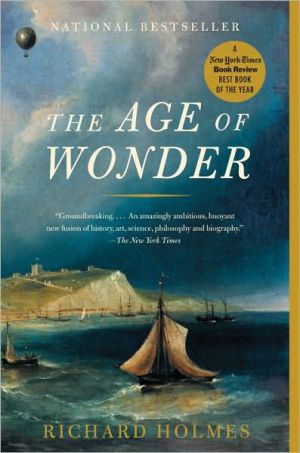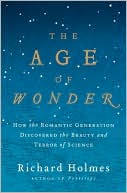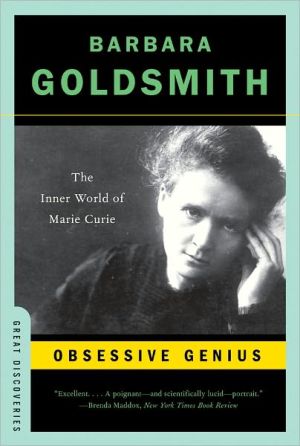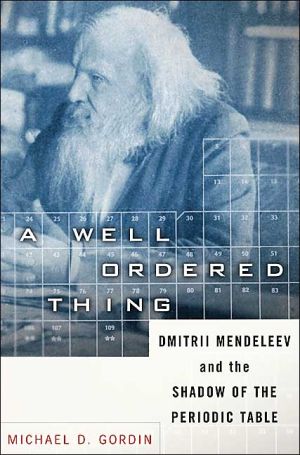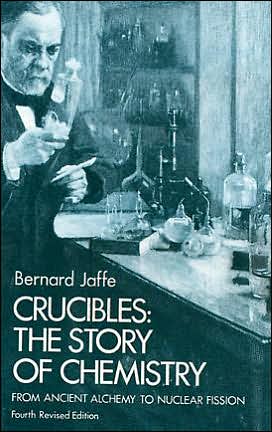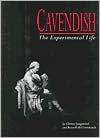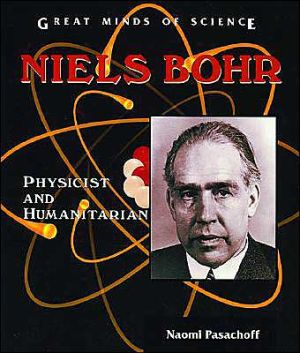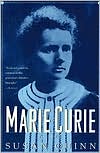The Age of Wonder: The Romantic Generation and the Discovery of the Beauty and Terror of Science
The Age of Wonder is a colorful and utterly absorbing history of the men and women whose discoveries and inventions at the end of the eighteenth century gave birth to the Romantic Age of Science. \ When young Joseph Banks stepped onto a Tahitian beach in 1769, he hoped to discover Paradise. Inspired by the scientific ferment sweeping through Britain, the botanist had sailed with Captain Cook in search of new worlds. Other voyages of discovery—astronomical, chemical, poetical,...
Search in google:
The Age of Wonder is a colorful and utterly absorbing history of the men and women whose discoveries and inventions at the end of the eighteenth century gave birth to the Romantic Age of Science. When young Joseph Banks stepped onto a Tahitian beach in 1769, he hoped to discover Paradise. Inspired by the scientific ferment sweeping through Britain, the botanist had sailed with Captain Cook in search of new worlds. Other voyages of discovery—astronomical, chemical, poetical, philosophical—swiftly follow in Richard Holmes's thrilling evocation of the second scientific revolution. Through the lives of William Herschel and his sister Caroline, who forever changed the public conception of the solar system; of Humphry Davy, whose near-suicidal gas experiments revolutionized chemistry; and of the great Romantic writers, from Mary Shelley to Coleridge and Keats, who were inspired by the scientific breakthroughs of their day, Holmes brings to life the era in which we first realized both the awe-inspiring and the frightening possibilities of science—an era whose consequences are with us still. The Barnes & Noble Review I'll admit I was stunned to learn that the chemist Sir Humphry Davy was so well acquainted with the poets Samuel Taylor Coleridge and William Wordsworth -- and furthermore to find them all collegially botanizing, geologizing, analyzing, and versifying through that yeasty interdisciplinary era that Richard Holmes calls the "Age of Wonder." It was a time defined by two great voyages: James Cook's passage to Tahiti aboard the Endeavour to observe the 1769 transit of Venus, and the surveying mission of the Beagle, which set out in 1831, carrying the young Charles Darwin to the Galápagos Islands. Within those Romantic six decades, the universe opened wider as William Herschel discovered the planet Uranus and the first balloonists realized the dreams of Icarus.
Chapter 1\ Joseph Banks in Paradise\ 1\ On 13 April 1769, young Joseph Banks, official botanist to HM Bark Endeavour, first clapped eyes on the island of Tahiti, 17 degrees South, 149 degrees West. He had been told that this was the location of Paradise: a wonderful idea, although he did not quite believe it.\ \ Banks was twenty-six years old, tall and well-built, with an appealing bramble of dark curls. By temperament he was cheerful, confident and adventurous: a true child of the Enlightenment. Yet he had thoughtful eyes and, at moments, a certain brooding intensity: a premonition of a quite different sensibility, the dreaming inwardness of Romanticism. He did not like to give way to it. So he kept good company with his shipmates, and had carefully maintained his physical fitness throughout the first eight months of the voyage. He regarded himself – ‘thank god’ – as in as good mental and physical trim as a man could be. When occasionally depressed, he did vigorous jumping ‘rope exercises’ in his cabin, once nearly breaking his leg while skipping.\ He was capable of working patiently for hours on end in the extremely cramped conditions on board. The quarterdeck cabin, which he shared with his friend Dr Daniel Solander, was approximately eight feet by ten. He had adopted a strict daily routine of botanical drawing, electrical experiments, animal dissections, deck-walking, bird-shooting (when available) and journal-writing. He constantly fished specimens from the sea, shot or netted wild birds, and observed meteorological phenomena, such as the beautiful ‘lunar rainbows’. When his gums had begun bleeding ominously with the onset of scurvy, he had calmly treated himself with a specially pre-prepared syrup (‘Dr Hume’s mixture’) of concentrated lemon juice, taking precisely six ounces a day. Within a week he was cured.\ Just occasionally young Banks’s scientific enthusiasm turned to explosive impatience. When rudely prevented from carrying out any botanical field trips by the Spanish Consul at Rio de Janeiro, and confined for three weeks to the sweltering ship in the harbour at Rio, he wrote colourfully to a friend at the Royal Society: ‘You have heard of Tantalus in hell, you have heard of the French man laying swaddled in linen between two of his Mistresses both naked using every possible means to excite desire. But you have never heard of a tantalized wretch who has born his situation with less patience than I have done mine. I have cursed, swore, raved, stamped.’ Banks did however unofficially slip over the side at night to collect wild seeds and plants, a hoard which included the exotic purple bougainvillea.\ Once among the Polynesian isles, Banks spent hours at the topgallant masthead, his large form crouched awkwardly in the crow’s nest, looking for landfall beneath the heavy tropical cloudbase. At night the crew would hear distant surf roaring through the dark. Now at last he gazed out at the fabled blue lagoon, the black volcanic sand, and the intriguing palm trees (Linnaeus’s Arecaceae). Above the beach the precipitous hills, dense with dark-green foliage and gleaming with white streams, rose sharply to 7,000 feet. On the naval chart Banks noted that the place was marked, prosaically enough, ‘Port Royal Bay, King George the Third’s Island’. ‘As soon as the anchors were well down the boats were hoisted out and we all went ashore where we were met by some hundreds of the inhabitants whose faces at least gave evident signs that we were not unwelcome guests, tho they at first hardly dare approach us. After a little time they became very familiar. The first who aproachd us came creeping almost on his hands and knees and gave us a green bough the token of peace.’\ Taking the hint, all the British shore party pulled down green boughs from the surrounding palm trees and carried them along the beach, waving them like ceremonial parasols. Eventually they were shown an idyllic spot close by a stream, where it was indicated that they could set up camp. The green boughs were thrown down in a great pile on the sand, ‘and thus peace was concluded’. Here the British settlement known as Fort Venus was to be established: ‘We then walkd into the woods followd by the whole train to whom we gave beads and small presents. In this manner we walked for 4 or 5 miles under groves of Cocoa nut and Bread fruit trees loaded with a profusion of fruit and giving the most gratefull shade I have ever experienced. Under these were the habitations of the people most of them without walls. In short the scene we saw was the truest picture of an Arcadia of which we were going to be Kings that the imagination can form.’\ As the men walked back, feeling dangerously like royalty, the Tahitian girls draped them with flowers, offered ‘all kind of civilities’ and gestured invitingly towards the coconut mats spread in the shade. Banks felt, reluctantly, that since islanders’ houses were ‘entirely without walls’ it was not quite the moment to ‘put their politeness to every test’. He would not have failed to have done so ‘had circumstances been more favourable’.\ 2\ Tahiti lies roughly east–west just below the 17th parallel, one of the largest of what are now the Society Islands, roughly halfway between Peru and Australia. It is shaped not unlike a figure of eight, some 120 miles (‘40 leagues’) in circumference. Most of its foreshores are easily accessible, a series of broad, curving bays with black volcanic sands or pinkish-white coral beaches, fringed by coconut palms and breadfruit trees. But a few hundred yards inland, the ground rises sharply into an entirely different topography. The steep, densely wooded volcanic hills lead upwards to a remote and hostile landscape of deep gullies, sheer cliffs and perilous ledges.\ Contrary to legend, the Endeavour, commanded by Lieutenant James Cook, was not the first European ship to make landfall in Tahiti. Spanish expeditions, under Quiroz or Torres, had probably touched there in the late sixteenth century, and claimed it for Spain. A previous English expedition, under Captain Wallis of the Dolphin, had definitely landed there in 1767, when it was described as ‘romantic’, and claimed for England. A French expedition under Louis-Antoine de Bougainville had anchored there the following year, and claimed it for France.\ The French had racily christened Tahiti ‘La Nouvelle Cythère’, the New Island of Love. Banks’s opposite number, the French botanist Philibert Commerson (who named the bougainvillea after his captain), had published a sensational letter in the Mercure de France describing Tahiti as a sexual ‘Utopia’. It proved that Jean-Jacques Rousseau was right about the existence of the Noble Savage. But then, the French had only spent nine days on the island.\ Cook was more sceptical, and had every member of his crew (including the officers) examined for venereal infections four weeks before arriving, by their surgeon Jonathan Monkhouse. He issued a series of Landing Instructions, which stated that the first rule of conduct ashore was civilised behaviour: ‘To Endeavour by every fair means to cultivate a Friendship with the Natives and to treat them with all Imaginable Humanity.’ It was no coincidence that he enshrined the ship’s own name in this instruction.\ Joseph Banks had his own views on Paradise. He gave a whimsical account of his first night ashore in his Endeavour Journal. He dined deliciously on dressed fish and breadfruit, next to a Tahitian queen, who ‘did me the honour with very little invitation to squat down on the mats close by me’. However, the queen was ‘ugly enough in conscience’. Banks then noticed a very pretty girl, ‘with a fire in her eyes’ and white hibiscus in her hair, lingering in the ‘common crowd’ at the door. He encouraged her to come and sit on his other side, studiously ignored the queen for the rest of the evening, and ‘loaded’ the Polynesian beauty with bead necklaces and every compliment he could manage. ‘How this would have ended is hard to say,’ he observed later. In fact the amorous party broke up abruptly when it was discovered that his friend Solander had had a snuffbox picked from his pocket, and a fellow officer had lost ‘a pair of opera glasses’. It is not explained why he had brought opera glasses ashore in the first place.\ This thieving proved to be completely customary in Tahiti, and led to many painful misunderstandings on both sides. The first occurred the following day, when a Tahitian quite openly made off with a marine’s musket, and was immediately shot dead by a punctilious guard. Banks quickly grasped that some quite different notion of property must be involved, and noted grimly: ‘We retird to the ship not well pleasd with the days expedition, guilty no doubt in some measure of the death of a man who the most severe laws of equity would not have condemnd to so severe a punishment. No canoes about the ship this morning, indeed we could not expect any as it is probable that the news of our behaviour yesterday was now known every where, a circumstance which will doubtless not increase the confidence of our friends the Indians.’ Nonetheless, to Banks’s relief and evident surprise, good relations were restored within twenty-four hours.\ The Endeavour expedition remained for three months on Tahiti. Its main object was to observe a Transit of Venus across the face of the sun. (Cook stated that this was the reason their settlement was named Fort Venus, though his junior officers gave a different explanation.) This was due on the morning of 3 June 1769, and there would be no other transit for the next hundred years (not until 1874). It was a unique chance to establish the solar parallax, and hence the distance of the sun from the earth. This calculation depended on observing the exact timing at which the silhouette of Venus first entered, and then exited from, the sun’s disc.\ Banks was not part of the astronomical team, but when the expedition’s quadrant was stolen one night shortly before the transit was due, he reacted with characteristic energy and courage. He knew that without this large and exquisitely calibrated brass instrument, used to measure precise astronomical angles, the entire observation would be rendered valueless. Not waiting for Cook or his marine guards, Banks roused the expedition’s official astronomer, William Green, and set off immediately on foot in pursuit of the thief. In the dizzy heat, Banks followed the trail far up into the hills, accompanied only by a reluctant Green, one unarmed midshipman and a Tahitian interpreter. They penetrated seven miles inland through the Tahitian jungle, further than any European had been before: ‘The weather was excessive hot, the Thermometer before we left the tents up at 91 made our journey very tiresome. Sometimes we walk’d sometimes we ran when we imagind (which we sometimes did) that the chase was just before us till we arrivd at the top of a hill about 4 miles from the tents. From this place [the interpreter] Tubourai shew’d us a point about 3 miles off and made us understand that we were not to expect the instrument till we got there. We now considerd our situation. No arms among us but a pair of pocket pistols which I always carried; going at least 7 miles from our fort where the Indians might not be quite so submissive as at home; going also to take from them a prize for which they had ventured their lives.’\ Banks decided to send back the midshipman with a brief message to Cook that armed reinforcements would be welcome. Meanwhile he and Green would press on alone, ‘telling him at the same time that it was impossible we could return till dark night’.\ Before dusk, Banks ran the thief to ground in an unknown and potentially hostile village. A crowd quickly gathered round them, ‘rudely’ jostling them. Following a Tahitian custom he had already learned, Banks quickly drew out a ring on the grass, and surrounded by ‘some hundreds’ of faces, sat quietly down in the centre. Here, instead of threatening or blustering, he began to explain and negotiate. For some time nothing transpired. Then, piece by piece, starting with its heavy wooden deal case, the quadrant was solemnly returned. ‘Mr Green began to overlook the Instrument to see if any part or parts were wanting… The stand was not there but that we were informd had been left behind by the thief and we should have it on our return… Nothing else was wanting but what could easily be repaired, so we pack’d all up in grass as well as we could and proceeded homewards.’\ By the time armed marines came up, sweating and jittery, about two miles down the track, Banks had completed the transaction and made several new friends. Everyone returned peacefully to Fort Venus on the shore. For this exploit, all conducted with the greatest calm and good humour, Banks earned the profound gratitude of Cook, who noted that ‘Mr Banks is always very alert upon all occasions wherein the Natives are concerned.’ Banks concluded mildly in his journal: ‘All were, you may imagine, not a little pleased at the event of our excursion.’\ Banks and Cook were a seemingly ill-matched pair. They were divided by background, education, class and manners. Yet they formed a curiously effective team. Cook’s cool and formal manners towards the Tahitians were balanced by Banks’s natural openness and enthusiasm, which easily won friends. With their help he would gather a mass of plant and animal specimens, and make what was in effect an early anthropological study of Tahitian customs. His journal entries cover everything from clothes (or lack of them) and cookery to dancing, tattooing, sexual practices, fishing methods, wood-carving, and religious beliefs. His accounts of a dog being roasted, or a young woman having her buttocks tattooed, are frank and unforgettable. He attended Tahitian ceremonial events, slept in their huts, ate their food, recorded their customs and learned their language. He was pioneering a new kind of science. As he wrote in his journal: ‘I found them to be a people so free from deceit that I trusted myself among them almost as freely as I could do in my own countrey, sleeping continually in their houses in the woods with not so much as a single companion.’
List of illustrations1 Joseph Banks in Paradise 12 Herschel on the Moon 603 Balloonists in Heaven 1254 Herschel Among the Stars 1635 Mungo Park in Africa 2116 Davy on the Gas 2357 Dr. Frankenstein and the Soul 3058 Davy and the Lamp 3379 Sorcerer and Apprentice 38110 Young Scientists 435Cast List 471Bibliography 485References 497Index 531\\
\ Christopher BenfeyIn this big two-hearted river of a book, the twin energies of scientific curiosity and poetic invention pulsate on every page.\ —The New York Times Book Review\ \ \ \ \ Janet Maslin…amazingly ambitious, buoyant new fusion of history, art, science, philosophy and biography\ —The New York Times\ \ \ Michael DirdaAs seems appropriate, Holmes's enthralling book itself exemplifies those qualities fostered by a scientific culture: "the sense of individual wonder, the power of hope, and the vivid but questing belief in a future for the globe."\ —The Washington Post\ \ \ \ \ Publishers WeeklyThe Romantic imagination was inspired, not alienated, by scientific advances, argues this captivating history. Holmes, author of a much-admired biography of Coleridge, focuses on prominent British scientists of the late 18th and early 19th centuries, including the astronomer William Herschel and his accomplished assistant and sister, Caroline; Humphrey Davy, a leading chemist and amateur poet; and Joseph Banks, whose journal of a youthful voyage to Tahiti was a study in sexual libertinism. Holmes's biographical approach makes his obsessive protagonists (Davy's self-experimenting with laughing gas is an epic in itself) the prototypes of the Romantic genius absorbed in a Promethean quest for knowledge. Their discoveries, he argues, helped establish a new paradigm of "Romantic science" that saw the universe as vast, dynamic and full of marvels and celebrated mankind's power to not just describe but transform Nature. Holmes's treatment is sketchy on the actual science and heavy on the cultural impact, with wide-ranging discussions of the 1780s ballooning craze, Mary Shelley's Frankenstein and scientific metaphors in Romantic poetry. It's an engrossing portrait of scientists as passionate adventurers, boldly laying claim to the intellectual leadership of society. Illus. (July 14)\ Copyright © Reed Business Information, a division of Reed Elsevier Inc. All rights reserved.\\\ \ \ \ \ Library JournalWhile Romanticism in Great Britain is known mostly as an artistic, literary, and intellectual movement, rapid and revolutionary scientific discoveries were an underlying catalyst to the era's vaunted sense of "wonder." It was also a period when remarkable individuals working alone could make major contributions to knowledge. Historian and biographer Holmes (Dr. Johnson & Mr. Savage) conveys the history of Romantic-era science through vivid biographies of a few such individuals. Notable among them are Joseph Banks, a botanist whose experiences in Tahiti were life-changing; William Herschel, the eccentric astronomer who (aided invaluably by his devoted sister, Caroline) discovered the planet Uranus; and Humphrey Davy, an intrepid chemist who conducted gas inhalation experiments on himself. These and others are depicted against the cultural tapestry of an age of idealism, which was both fueled and threatened by the advances of science. The subject makes this book most relevant for readers of general science and history of science, but its engaging narratives of the period could appeal to a broader readership. [See Prepub Alert, LJ3/1/09.]\ —Gregg Sapp\\\ \ \ \ \ \ Kirkus ReviewsEnergetic analysis of the "Romantic Age of Science."Romanticism, the deeply emotional artistic movement of the second half of the 18th century, was partly a reaction against the pragmatism of Enlightenment scientists. However, British historian Holmes (Sidetracks: Explorations of a Romantic Biographer, 2000, etc.) writes, the divide between scientific endeavors and artistic pursuits was not always so clearly delineated. The author focuses primarily on the lives of two men who straddled both worlds, who embraced "Romantic science" and pursued it with the passion of poets or painters. Astronomer William Herschel, who discovered the planet Uranus in 1781, started his career as a musician. That led to an interest in mathematics and then astronomy, which he pursued with the same emotional fervor as any classical music piece. He even compared his skill at seeing astronomical phenomena with the skill required to play Handel's fugues. Holmes also looks at the British chemist Humphry Davy, who, among other accomplishments, discovered that chlorine and iodine were elements. Early on, Davy wrote poetry, and later became friends with Samuel Taylor Coleridge. One of his poems celebrated "science, whose delicious water flows / From Nature's bosom." Davy's enthusiasm led to risky, self-destructive behavior-he often inhaled strange chemical gases as experiments, a practice that nearly killed him. While partaking of nitrous oxide with acquaintances, he extolled the glories of science: "I dream of Science restoring to Nature what Luxury, what Civilization have stolen from her-pure hearts, the forms of angels, bosoms beautiful, and panting with Joy & Hope." Davy may have had a brilliant scientist's brain,but he had the heart and soul of a poet. How these two contradictory ideas not only coexisted, but flourished together during the Romantic era, makes for engrossing reading. Enjoyable excavation of a time when science and art fed off each other, to the benefit of both communities.\\\ \ \ \ \ The Barnes & Noble ReviewI'll admit I was stunned to learn that the chemist Sir Humphry Davy was so well acquainted with the poets Samuel Taylor Coleridge and William Wordsworth -- and furthermore to find them all collegially botanizing, geologizing, analyzing, and versifying through that yeasty interdisciplinary era that Richard Holmes calls the "Age of Wonder." It was a time defined by two great voyages: James Cook's passage to Tahiti aboard the Endeavour to observe the 1769 transit of Venus, and the surveying mission of the Beagle, which set out in 1831, carrying the young Charles Darwin to the Galápagos Islands. Within those Romantic six decades, the universe opened wider as William Herschel discovered the planet Uranus and the first balloonists realized the dreams of Icarus. \ \\ \\ The author describes his text as "a relay race of scientific stories" that "tries to capture something of the inner life of science, its impact on the heart as well as on the mind." In this the book succeeds with verve. I didn't just read The Age of Wonder; I escaped to it, riding happily with its heroes through a blaze of adventures and ideas.\ \\ Finally getting to her feet as the balloon floated over Green Park, Mrs. Sage trod on Lunardi's barometer and broke it, thus depriving Mr. Biggin of any instrument with which to measure their height. Nevertheless, in due course the two of them were lunching peacefully off sparkling Italian wine and cold chicken, occasionally calling to people below through a speaking-trumpet. The flight followed the line of the Thames westwards, at one point passing through a snowstorm (surprising for mid-June, remarked Mr. Biggin nonchalantly [according to Mrs. Sage's published report]), and landed heavily near Harrow on the Hill, smashing through a hedge and dragging across an unharvested hayfield.\ \\ \\ Although Davy and Herschel -- and Herschel's sister Caroline, the comet hunter -- are the acknowledged stars of this book, their tales and others are stitched together via the giant personage of Sir Joseph Banks, who won 41 consecutive elections as president of the Royal Society (a string of successes ended only by his death in 1820). We first encounter Banks as a youth, on the decks of the Endeavour. He was "Joseph Banks in Paradise" then, as the title of Chapter 1 describes him, exploring Mother Nature by day and lying with his Tahitian paramour at night. By the end of his life, which comes in Chapter 9, "Sorcerer and Apprentice," Banks rued the decline of a unified scientific enterprise -- not an end to wonder per se, which has not ceased even today, but a channeling of intellects into categories. Commenting on the establishment of the Geological Society in 1807 and the prospect of an Astronomical Society (to come in 1820), he wrote, "I see plainly that all these new-fangled Associations will finally dismantle the Royal Society, and not leave the Old Lady a rag to cover her."\ \\ \\ Did I mention that Davy also knew Walter Scott and Lord Byron? That he wrote his own poetry -- in his laboratory notebooks? It wasn't great poetry (Holmes offers many examples), but then, Davy established the foundation of modern chemistry, ran the Royal Institution, identified the element iodine, isolated potassium and sodium by electrolysis, nearly died of "jail fever" while revising the ventilation system at Newgate Prison, and invented a safety lamp for coal miners that halted a horrific series of fatal explosions.\ \\ \\ The Davy Safety Lamp, described as "the greatest public achievement of his career," spread all over the continent and became the icon on Davy's coat of arms. His heraldic motto stated, "I built the light which brings safety." The basic research on methane that Davy undertook at the start of his efforts for the miners led to the fundamental yet counterintuitive discovery that a lamp's flame fails to pass through a wire mesh. (Chemistry students to this day continue to be amazed by holding a wire screen over a Bunsen burner and observing its flame thus contained.) Davy said of the final design, which consisted of a cotton-wick oil lamp enclosed in a column of fine iron mesh, that it confined the destructive flame "like a bird in a cage." Improving on Davy's simile, Holmes writes: "[Davy] went down 'G' pit at Walls End, spent some two hours beneath the surface, and...delivered an impromptu fifteen-minute lecture on using the lamp safely, stressing the need to avoid strong air currents or clouds of coal dust, which could still risk freak explosions. He also pointed out that the state of the flame indicated the presence, and even the strength, of fire-damp in a shaft. His lamp not only caged the flame, it transformed it into a canary."\ \\ \\ Banks saw to it that Davy was awarded the Rumford Medal for this achievement and publicly defended him against a rival who (mistakenly) claimed priority. The always helpful Banks also brokered the relationship between the Herschels and King George III. Herschel needed large sums to build his enormous telescopes, and Banks finessed many of the financial transactions. In one of his typically friendly letters he expressed, "My best Compliments to Mr Herschell, with best wishes for the Sake of Science that his nights may be as Sleepless as he can wish them himself."\ \\ \\ This book often reads like a novel, but it offers admirable documentation and appended information to support its abundance of factual material. It contains the best index I have ever perused. Usually reviewers read galley copies that don't yet have an index, and even when the index is added later to the finished book, it often doesn't provide much. The index to The Age of Wonder is so generously detailed that it should serve as a paragon. Its entry on Michael Faraday, for example, fills an entire column of tiny print, with subheadings such as "character and appearance," "injured in laboratory explosion," and "friendship with Coleridge."\ \\ \\ If the age witnessed a great awakening in the naming of new constellations and the first classification of clouds by the nascent science of meteorology, it also knew the awful wakefulness of surgery in the absence of anesthesia. Holmes recounts how, in 1811, "the Herschels' old friend Fanny Burney...underwent an agonizing operation for breast cancer without anesthetic. It was carried out by an outstanding French military surgeon, Dominique Larrey, in Paris, and so successfully concluded that she lived for another twenty years. What is even more remarkable, Fanny Burney remained conscious throughout the entire operation, and subsequently wrote a detailed account of this experience, watching parts of the surgical procedure through the thin cambric cloth that had been placed over her face. At the time the surgeon did not realize that the material was semi-transparent: "I refused to be held; but when, bright through the cambric, I saw the glitter of polished steel -- I closed my eyes. I would not trust to convulsive fear the sight of the terrible incision."\ \\ \\ I have only one quibble with Mr. Holmes, which is that he sometimes grows too speculative about the motivations of his subjects. Having spent so much time reading their mail and their diaries, I suppose he cannot help but express his own interpretation of their innermost intent.\ \\ \\ I forgive him, of course, and thank him for the marvelous synthesis he has created in these pages, as when he considers the global climate change effected by the April 1815 Tambora volcano in Indonesia:\ \\ Pink snow fell in Italy, and the harvest failed in France, Germany and England. Byron, exiled from Britain and passing this summer on Lac Leman with Shelley, wrote his poem 'Darkness,' reflecting on the possibilities of a future cosmological catastrophe, as hinted at by Herschel's late papers.\ \\ \\ I had a dream which was not all a dream.\ \\ The bright sun was extinguished, and the stars\ \\ Did wander darkling in the eternal space,\ \\ Rayless, and pathless, and the icy earth\ \\ Swung blind and blackening in the moonless air...\ \\ \\ Long live wonder. --Dava Sobel\ \\ Dava Sobel is the author of Longitude, Galileo's Daughter, and The Planets. Her writings on the history of science have earned her awards from the National Science Board and the Boston Museum of Science, among others.\ \ \
